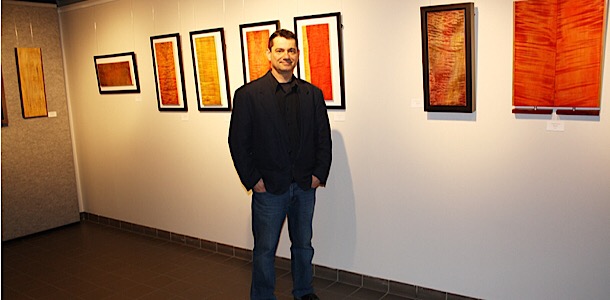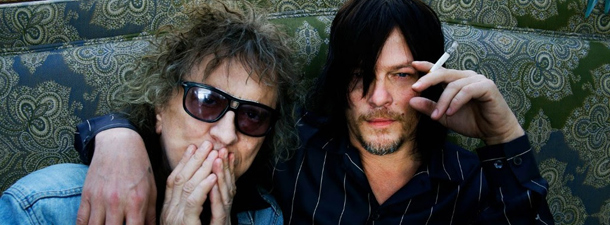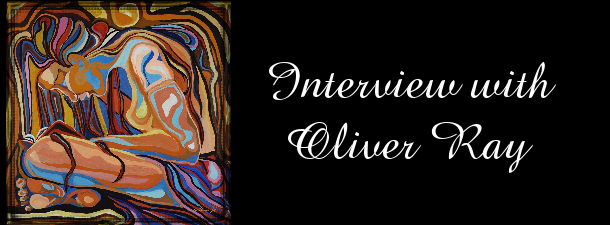Interview with artist and designer Norman Pirollo

Artwork offers viewers a chance to look upon work that makes them feel emotion—be it amusement, shock, or even confusion. The abstract form is the most subjective of all styles and the artwork of Norman Pirollo is a fine example of creations that can be interpreted differently depending on each individual viewer.
Norman Pirollo is an artist based in Ontario, Canada, who works with a variety of media. An IT expert turned furniture designer by trade, Norman currently has a book in the works that chronicles his journey of transitioning from being a sculptor with wood to micro art, micro painting and then abstract painting. “In the sculpting phase I began to develop an appreciation for figured woods with abstract graphics,” Norman explained. “I would incorporate these woods in my designer furniture, then into sculptures. The sculptures evolved from fairly linear work to organic work. This was the beginning of my affinity to abstraction. I talk about how I stumbled onto sculpture from essentially being a one of a kind furniture designer and maker.”
Norman has developed microscope art techniques (actually using a microscope) and has done micro painting using needle instruments on a 1” inch square. These pieces were photographed through macro lenses to become works of abstract art when the images were “scaled up.” Eventually, he migrated to full-scale painting.
 Incredibly, Norman is primarily self-taught in painting and has been studying art history for years, specifically the abstract expressionist (AbEx) movement. In fact, a large portion of his forthcoming book follows the creation of the movement, its origins and the preceding movements beginning with Impressionism (which is considered to be the beginning of abstraction). “I followed different AbEx members and their work to understand what style of abstraction I enjoyed. In many cases I would imitate the style of a few AbEx members to better understand abstract art,” stated Norman.
Incredibly, Norman is primarily self-taught in painting and has been studying art history for years, specifically the abstract expressionist (AbEx) movement. In fact, a large portion of his forthcoming book follows the creation of the movement, its origins and the preceding movements beginning with Impressionism (which is considered to be the beginning of abstraction). “I followed different AbEx members and their work to understand what style of abstraction I enjoyed. In many cases I would imitate the style of a few AbEx members to better understand abstract art,” stated Norman.
Clearly, Norman’s ultimate goal to create his own unique style panned out well since his art is presently very popular—he has even been invited to speak about art at events! Additionally, his work has been featured in several books including “Studio Furniture: Today’s Leading Woodworkers”, “Wood Art Today 2”, “500 Cabinets”, “Rooted,” “Ottawa Life” and various international magazines. He is the recipient of numerous art awards and has recently been selected as a finalist for the prestigious NICHE Award as well as a finalist for the Art Trends Artist of the Year Award.
Recently, Norman discussed his experiences being an artist:
Meagan Meehan (M.M.) of Entertainment Vine: How and when did you decide to become an artist?
 Norman Pirollo (N.P.): I actually stumbled onto the art scene seven years ago. Through my one of a kind furniture designs, I had to create scale maquettes or models to determine the viability of each design. Submitting one of these maquettes to a fine craft exhibition was successful and this led to other submissions and the gradual evolution into sculptural work with wood as a medium. The sculptural work progressed from linear and geometric shapes using natural colors to colored wood and more organic shapes. A brainstorm along the way inspired me to create wall art using highly figured colored woods. This was my introduction to hanging art. This step was my breakthrough into the greater art world. I then looked further into art and studied art history on my own and began to work on different forms of art gradually leading up to painting abstracts.
Norman Pirollo (N.P.): I actually stumbled onto the art scene seven years ago. Through my one of a kind furniture designs, I had to create scale maquettes or models to determine the viability of each design. Submitting one of these maquettes to a fine craft exhibition was successful and this led to other submissions and the gradual evolution into sculptural work with wood as a medium. The sculptural work progressed from linear and geometric shapes using natural colors to colored wood and more organic shapes. A brainstorm along the way inspired me to create wall art using highly figured colored woods. This was my introduction to hanging art. This step was my breakthrough into the greater art world. I then looked further into art and studied art history on my own and began to work on different forms of art gradually leading up to painting abstracts.
M.M.: Growing up, which artists/types of art interested you?
N.P.: Although it is almost expected to be excited about representational art, it never drew me in. I appreciated the Renaissance and post-Renaissance photo realistic art on its technical qualities, history and merits, but nothing more. I began to be drawn to abstract work instead, admiring abstract art from the early part of the 20th century.
Geometric forms, angular and linear work intrigued me. I discovered Kandinsky’s work through his affiliation with the Bauhaus School. This was done through my furniture design history research. I then researched other abstract artists of this era and slowly became immersed into abstract art.
M.M.: How would you describe your work and what inspires it?
 N.P.: My work is inspired through abstract expressionism, specifically the artists of the AbEx movement (New York School) and its off-shoots in Canada. This is art I could relate to. The lack of a subject or figure in this genre of art frees me from deliberately trying to reproduce an object or figure. Removal of subject matter inspires me to use color forms, shapes and lines instead. I like that I can use my emotion and gestural movements to transfer subconscious thought onto a canvas. I also enjoy working with complementary and contrasting colors in both vivid and subdued hues and tints.
N.P.: My work is inspired through abstract expressionism, specifically the artists of the AbEx movement (New York School) and its off-shoots in Canada. This is art I could relate to. The lack of a subject or figure in this genre of art frees me from deliberately trying to reproduce an object or figure. Removal of subject matter inspires me to use color forms, shapes and lines instead. I like that I can use my emotion and gestural movements to transfer subconscious thought onto a canvas. I also enjoy working with complementary and contrasting colors in both vivid and subdued hues and tints.
M.M.: You are also a furniture designer. What kinds of objects do you design and in what styles?
N.P.: I began by creating high-end boxes used as humidors and jewelry boxes. After considerable training, I decided to create furniture as the boxes began to be lacking in challenge. I was an admirer and follower of James Krenov, probably one of the leading furniture makers of the 20th century. He extolled the virtues of hand tools used to work wood. His philosophy was that the process and journey was equally as important as the final product. I learned to slow down and appreciate wood as a medium. I work almost exclusively with hand tools and my furniture is contemporary in style. My most recent direction has been to create unique designs in furniture through my furniture design studio.
M.M.: How did you go about getting into galleries?
N.P.: Contrary to expert advice, the process of formally submitting my portfolio to galleries never really worked for me. I had much better success at visiting the galleries and introducing myself and my work in casual conversation. I would ensure I talked to the gallerist and mention I was an artist. Then sent my CV and images in or direct them to my website. They were somewhat familiar with me at this point and provided feedback on my portfolio. I also attended as many art openings as possible, becoming acquainted with gallerists and art followers.
M.M..: Do you have a favorite piece? If so, which one and why?
 N.P.: My personal favorite is one of my most recent artworks, “Networking, 2015.” I was intrigued with Gerhard Richter’s work and the process and techniques he used to create his art. I liked that he walked away from a piece and returned the next day to continue. His style and process of creating art appealed to me greatly and so I created “Networking, 2015” and “Wildwood, 2015” using some of the same tools and processes Gerhard Richter used.
N.P.: My personal favorite is one of my most recent artworks, “Networking, 2015.” I was intrigued with Gerhard Richter’s work and the process and techniques he used to create his art. I liked that he walked away from a piece and returned the next day to continue. His style and process of creating art appealed to me greatly and so I created “Networking, 2015” and “Wildwood, 2015” using some of the same tools and processes Gerhard Richter used.
M.M.: What are your mediums of choice?
N.P.: I have chosen acrylic paints as my medium. I like that Acrylics are fast-drying which lends itself well to the layering process I use in my art. Sometimes it doesn’t dry fast enough, I wait for a layer to skin over and continue. I did dabble with oil paints but found the drying time extremely long and the fumes were over-powering.
M.M.: Are there any mediums that you haven’t worked with yet but hope to soon?
N.P.: I am content with acrylic paints and still in the process of exploring this medium and the variations in paint grades and viscosity.
M.M.: You mentioned being deeply influenced by New York School of Abstract Expressionists (AbEx). Can you please explain a little bit more about this movement?
 N.P.: I became drawn to this movement while researching the evolution of abstract art. The previous art movements to AbEx were somehow linked to objectivity and representation, but the AbEx artists took a leap of faith and completely separated their art from realism. This was a period of time (1943-60) when good art was supposed to be representative of a figure or object. Abstract art was an emerging trend and not yet accepted as mainstream art. It was radical and fringe art, at least in the early years. I like how the AbEx collective members could care less about being accepted and continued to develop their individual expressive art styles. I like the freedom they enjoyed in pursuing their vision of art as I also enjoy being liberated from expectations.
N.P.: I became drawn to this movement while researching the evolution of abstract art. The previous art movements to AbEx were somehow linked to objectivity and representation, but the AbEx artists took a leap of faith and completely separated their art from realism. This was a period of time (1943-60) when good art was supposed to be representative of a figure or object. Abstract art was an emerging trend and not yet accepted as mainstream art. It was radical and fringe art, at least in the early years. I like how the AbEx collective members could care less about being accepted and continued to develop their individual expressive art styles. I like the freedom they enjoyed in pursuing their vision of art as I also enjoy being liberated from expectations.
M.M.: To date, what has been the most rewarding experience involving your artwork and/or being an artist?
N.P.: I still get excited about being accepted into an exhibition, especially if it is a prestigious one. Having been accepted for a solo exhibition at a City of Ottawa gallery has probably been the high point of my art career thus far. I also use social media to get my work out here and certain pieces receive considerable kudos. This continues to be exciting and inspires me to continue! Having my work published in books and magazines is always rewarding. To be where I am in the art world today after only a few short years still amazes me!
M.M.: What advice would you give to someone who is aspiring to become an artist?
N.P.: Start early and develop a voice and style. Don’t get caught up with creating art that you think will sell. If you as an artist are not happy with creating the art, then the style you are working in is not the right one. I also feel that being successful early on stifles the creativity in an artist. Although it feels great to have stumbled on to a style of art that sells well, it might not be the style you ultimately want to work with. It is important to explore different styles of art before settling on a formula that works. I would also advise to hold off pursuing an art gallery until the emerging artists’ style and voice have been determined. Galleries do not particularly appreciate artists whose work is continually changing in style; at least this is my experience.
M.M.: Are there any upcoming projects and/or events that you would like to mention?
N.P.: I have in the past 15 months I have completed the book “ABSTRACTED: An Artist’s Journey.” The book is the story of how I transitioned into the art world and specifically into abstract expressionist art. I have had to complete considerable research into the Abstract Expressionist movement to provide context. The final stages involved gathering images and obtaining copyright and licensing for a few of these images. I am excited about this book as it chronicles my journey from furniture maker to sculptor to abstract artist. This was accomplished in a few short years with much overlap. Many decisions had to be made in a short time. I was also faced with a steep learning curve of the art world. The challenge was often overwhelming but I persevered since I had the goal of being an artist in mind. The book was published late in 2015 under the “New Art Press” imprint. It is currently available at Amazon.
MM: Nice, anything else?
N.P. I have just completed writing my latest book “THE WOOD ARTIST: Creating Art Through Wood” in September 2017. The book describes how I discovered wood art and the transition into the art world and more specifically the contemporary wood art genre. Through a series of unforeseen opportunities, my wood art evolved from linear and geometric maquettes to pure, organic sculpture. Later, I discovered techniques of creating wood art along with developing a process of hanging the wood art from a wall. This direction was pursued as well.
The evolution begins with monochromatic wood art pieces, then the introduction of color to my work and finally to large, organic sculptures in the contemporary art genre. I performed considerable research into the Contemporary Art movement to provide context. The book is one of my best of four books and I am excited at how it chronicles my journey from furniture maker to sculptor to wood artist. Today, I see myself as a multi-disciplinary artist in the genres of abstract art, wood art and sculpture as well as microphotography. Becoming proficient in each of these genres was accomplished in a few short years and with much overlap. Several challenges had to be overcome in a short time. I was also faced with a steep learning curve of developing captivating wood art compositions in both sculpture and wall-mounted wood art. There is a short video available with insight into the contents of the book. “THE WOOD ARTIST: Creating Art Through Wood” will be available on October 01, 2017 through Amazon under the New Art Press imprint.
* * * * *
To learn more about Norman Pirollo visit his official art website and his official design website. He can also be followed via Facebook, Twitter, Instagram, and YouTube. His book can be purchased on Amazon here.



